Leadership and Management Roles and Theories in Sainsbury Plc Analysis
VerifiedAdded on 2022/11/24
|17
|5766
|162
Report
AI Summary
This report delves into the roles and characteristics of leaders and managers within Sainsbury Plc, contrasting their functions and responsibilities. It explores how leadership and management apply in different situational contexts, analyzing examples related to marketing and recruitment. The report defines and compares leaders and managers, their roles and characteristics. Different leadership theories, including situational, system, and contingency theories, are applied to the context of Sainsbury Plc to understand their impact on employee motivation and organizational performance. The report also examines the key approaches to operations management, the roles of leaders and managers in this domain, and assesses the factors impacting operational management and decision-making within the business environment. Overall, the report provides a comprehensive analysis of leadership, management, and operations within a real-world business setting.
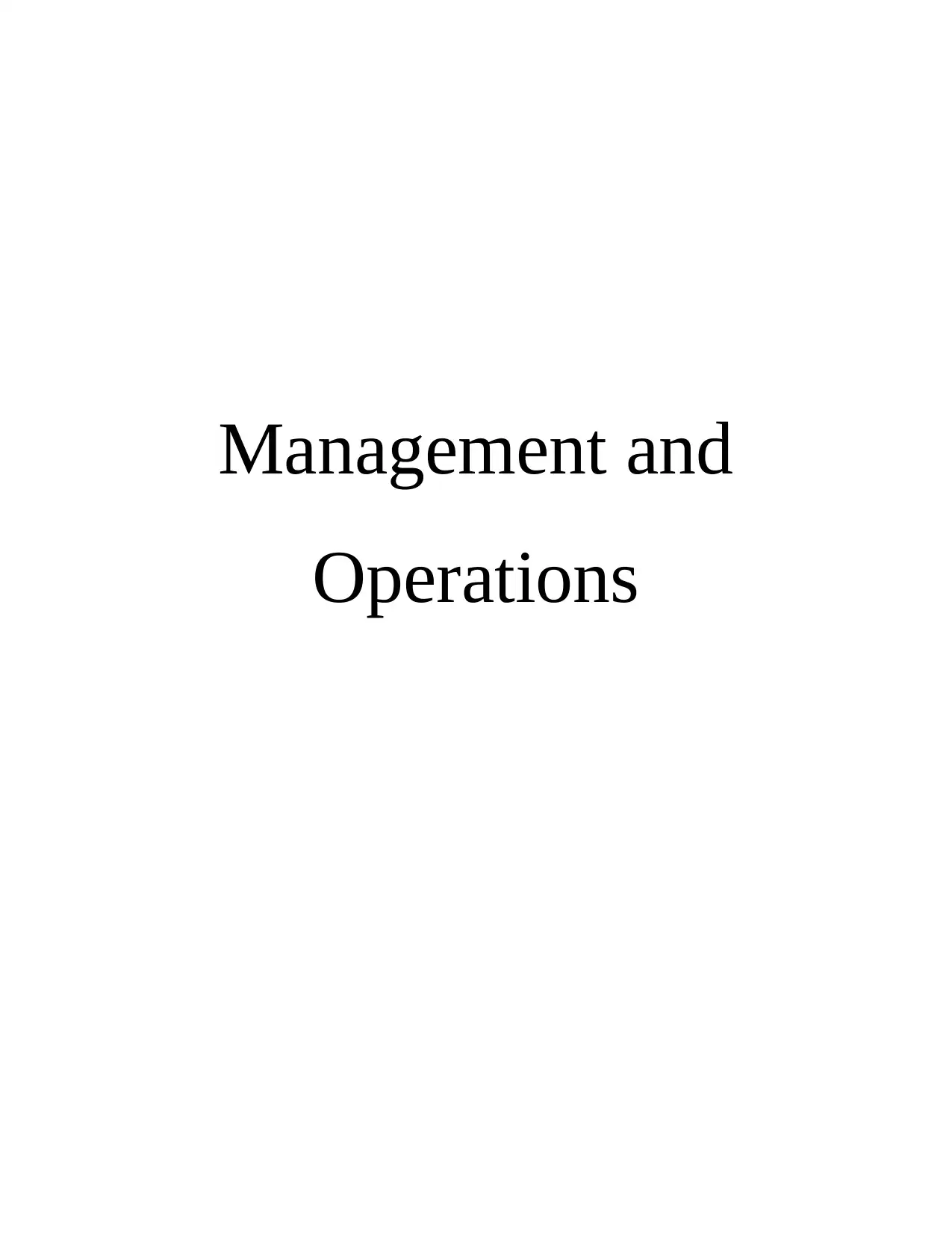
Management and
Operations
Operations
Paraphrase This Document
Need a fresh take? Get an instant paraphrase of this document with our AI Paraphraser
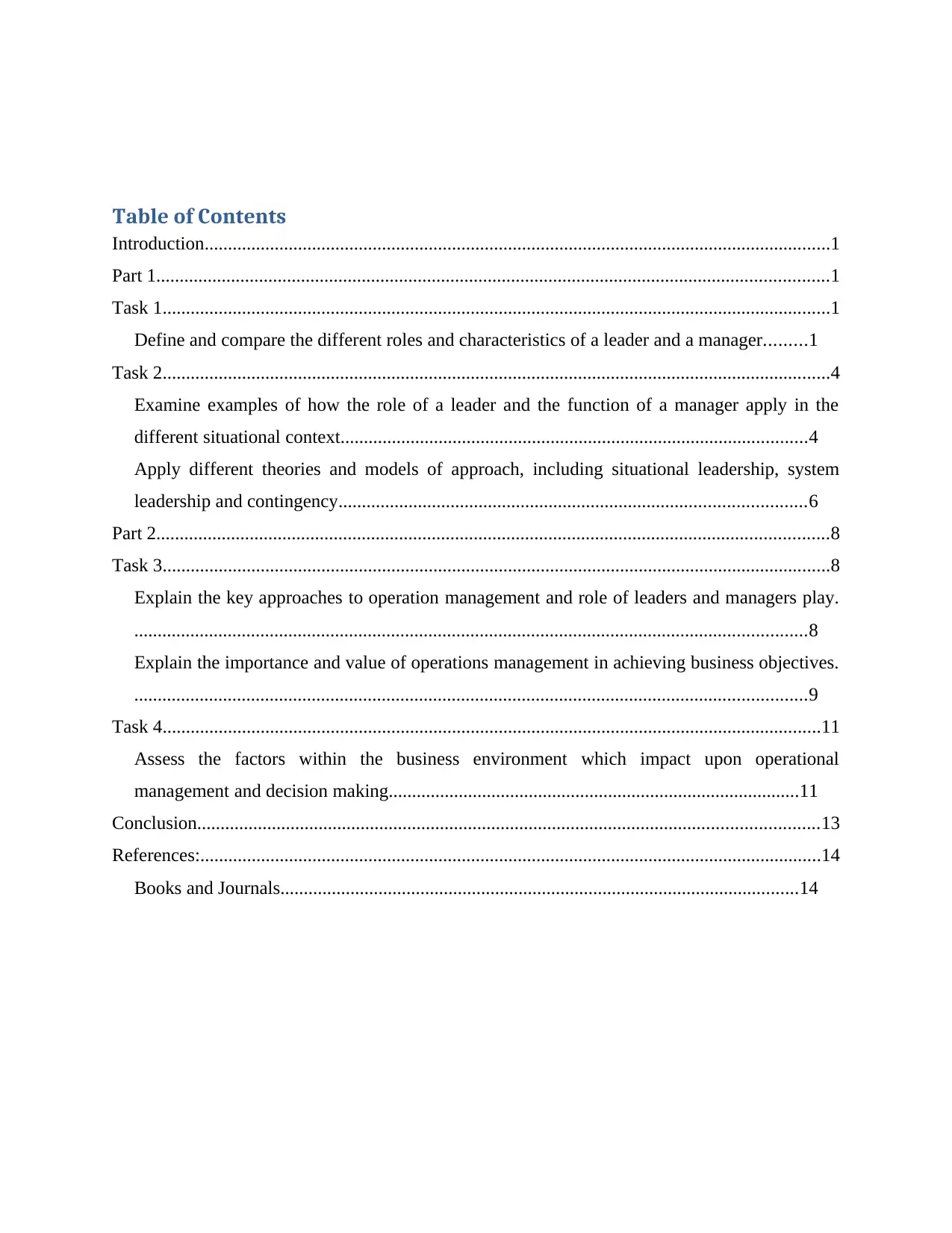
Table of Contents
Introduction......................................................................................................................................1
Part 1................................................................................................................................................1
Task 1...............................................................................................................................................1
Define and compare the different roles and characteristics of a leader and a manager.........1
Task 2...............................................................................................................................................4
Examine examples of how the role of a leader and the function of a manager apply in the
different situational context....................................................................................................4
Apply different theories and models of approach, including situational leadership, system
leadership and contingency....................................................................................................6
Part 2................................................................................................................................................8
Task 3...............................................................................................................................................8
Explain the key approaches to operation management and role of leaders and managers play.
................................................................................................................................................8
Explain the importance and value of operations management in achieving business objectives.
................................................................................................................................................9
Task 4.............................................................................................................................................11
Assess the factors within the business environment which impact upon operational
management and decision making........................................................................................11
Conclusion.....................................................................................................................................13
References:.....................................................................................................................................14
Books and Journals...............................................................................................................14
Introduction......................................................................................................................................1
Part 1................................................................................................................................................1
Task 1...............................................................................................................................................1
Define and compare the different roles and characteristics of a leader and a manager.........1
Task 2...............................................................................................................................................4
Examine examples of how the role of a leader and the function of a manager apply in the
different situational context....................................................................................................4
Apply different theories and models of approach, including situational leadership, system
leadership and contingency....................................................................................................6
Part 2................................................................................................................................................8
Task 3...............................................................................................................................................8
Explain the key approaches to operation management and role of leaders and managers play.
................................................................................................................................................8
Explain the importance and value of operations management in achieving business objectives.
................................................................................................................................................9
Task 4.............................................................................................................................................11
Assess the factors within the business environment which impact upon operational
management and decision making........................................................................................11
Conclusion.....................................................................................................................................13
References:.....................................................................................................................................14
Books and Journals...............................................................................................................14
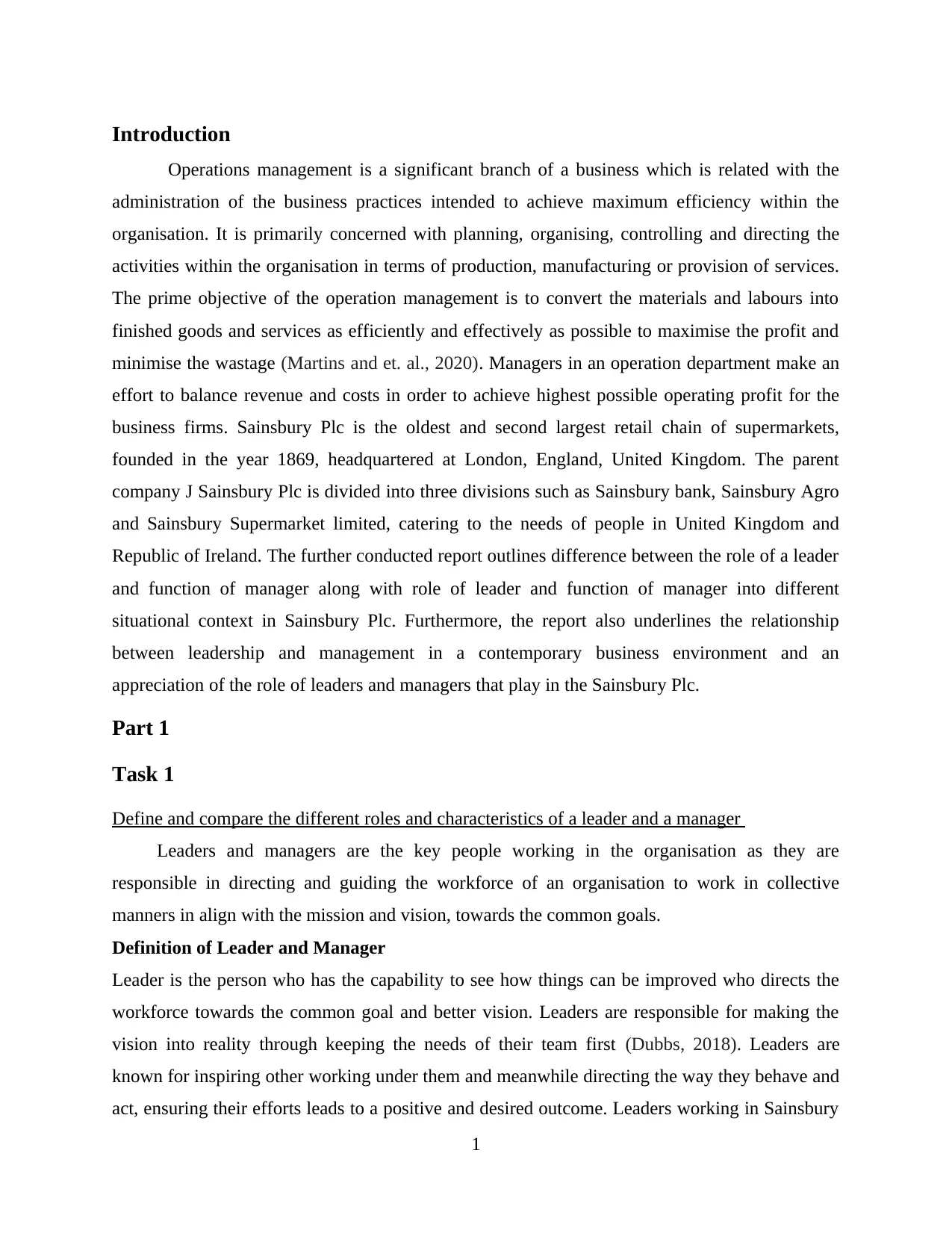
Introduction
Operations management is a significant branch of a business which is related with the
administration of the business practices intended to achieve maximum efficiency within the
organisation. It is primarily concerned with planning, organising, controlling and directing the
activities within the organisation in terms of production, manufacturing or provision of services.
The prime objective of the operation management is to convert the materials and labours into
finished goods and services as efficiently and effectively as possible to maximise the profit and
minimise the wastage (Martins and et. al., 2020). Managers in an operation department make an
effort to balance revenue and costs in order to achieve highest possible operating profit for the
business firms. Sainsbury Plc is the oldest and second largest retail chain of supermarkets,
founded in the year 1869, headquartered at London, England, United Kingdom. The parent
company J Sainsbury Plc is divided into three divisions such as Sainsbury bank, Sainsbury Agro
and Sainsbury Supermarket limited, catering to the needs of people in United Kingdom and
Republic of Ireland. The further conducted report outlines difference between the role of a leader
and function of manager along with role of leader and function of manager into different
situational context in Sainsbury Plc. Furthermore, the report also underlines the relationship
between leadership and management in a contemporary business environment and an
appreciation of the role of leaders and managers that play in the Sainsbury Plc.
Part 1
Task 1
Define and compare the different roles and characteristics of a leader and a manager
Leaders and managers are the key people working in the organisation as they are
responsible in directing and guiding the workforce of an organisation to work in collective
manners in align with the mission and vision, towards the common goals.
Definition of Leader and Manager
Leader is the person who has the capability to see how things can be improved who directs the
workforce towards the common goal and better vision. Leaders are responsible for making the
vision into reality through keeping the needs of their team first (Dubbs, 2018). Leaders are
known for inspiring other working under them and meanwhile directing the way they behave and
act, ensuring their efforts leads to a positive and desired outcome. Leaders working in Sainsbury
1
Operations management is a significant branch of a business which is related with the
administration of the business practices intended to achieve maximum efficiency within the
organisation. It is primarily concerned with planning, organising, controlling and directing the
activities within the organisation in terms of production, manufacturing or provision of services.
The prime objective of the operation management is to convert the materials and labours into
finished goods and services as efficiently and effectively as possible to maximise the profit and
minimise the wastage (Martins and et. al., 2020). Managers in an operation department make an
effort to balance revenue and costs in order to achieve highest possible operating profit for the
business firms. Sainsbury Plc is the oldest and second largest retail chain of supermarkets,
founded in the year 1869, headquartered at London, England, United Kingdom. The parent
company J Sainsbury Plc is divided into three divisions such as Sainsbury bank, Sainsbury Agro
and Sainsbury Supermarket limited, catering to the needs of people in United Kingdom and
Republic of Ireland. The further conducted report outlines difference between the role of a leader
and function of manager along with role of leader and function of manager into different
situational context in Sainsbury Plc. Furthermore, the report also underlines the relationship
between leadership and management in a contemporary business environment and an
appreciation of the role of leaders and managers that play in the Sainsbury Plc.
Part 1
Task 1
Define and compare the different roles and characteristics of a leader and a manager
Leaders and managers are the key people working in the organisation as they are
responsible in directing and guiding the workforce of an organisation to work in collective
manners in align with the mission and vision, towards the common goals.
Definition of Leader and Manager
Leader is the person who has the capability to see how things can be improved who directs the
workforce towards the common goal and better vision. Leaders are responsible for making the
vision into reality through keeping the needs of their team first (Dubbs, 2018). Leaders are
known for inspiring other working under them and meanwhile directing the way they behave and
act, ensuring their efforts leads to a positive and desired outcome. Leaders working in Sainsbury
1
⊘ This is a preview!⊘
Do you want full access?
Subscribe today to unlock all pages.

Trusted by 1+ million students worldwide
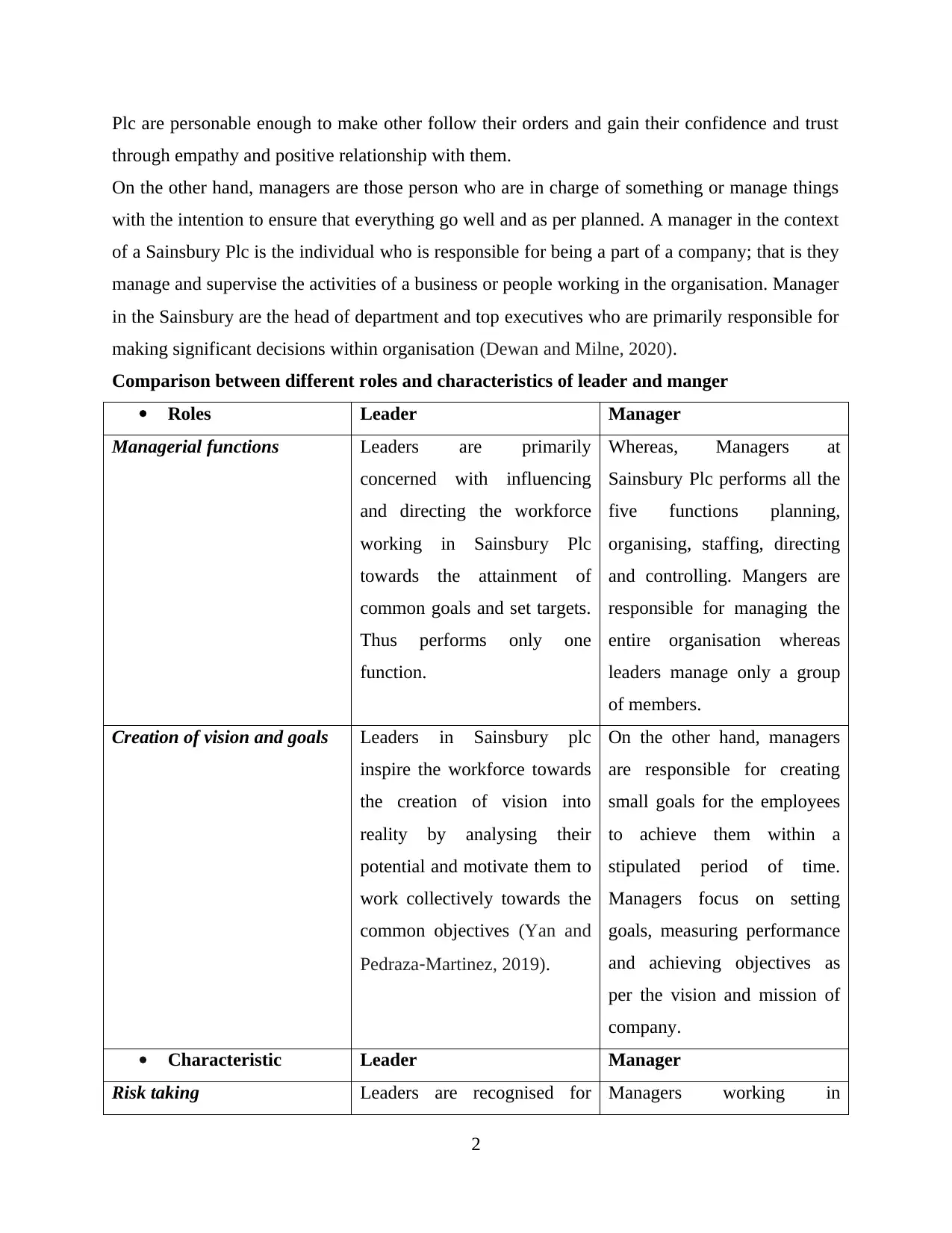
Plc are personable enough to make other follow their orders and gain their confidence and trust
through empathy and positive relationship with them.
On the other hand, managers are those person who are in charge of something or manage things
with the intention to ensure that everything go well and as per planned. A manager in the context
of a Sainsbury Plc is the individual who is responsible for being a part of a company; that is they
manage and supervise the activities of a business or people working in the organisation. Manager
in the Sainsbury are the head of department and top executives who are primarily responsible for
making significant decisions within organisation (Dewan and Milne, 2020).
Comparison between different roles and characteristics of leader and manger
Roles Leader Manager
Managerial functions Leaders are primarily
concerned with influencing
and directing the workforce
working in Sainsbury Plc
towards the attainment of
common goals and set targets.
Thus performs only one
function.
Whereas, Managers at
Sainsbury Plc performs all the
five functions planning,
organising, staffing, directing
and controlling. Mangers are
responsible for managing the
entire organisation whereas
leaders manage only a group
of members.
Creation of vision and goals Leaders in Sainsbury plc
inspire the workforce towards
the creation of vision into
reality by analysing their
potential and motivate them to
work collectively towards the
common objectives (Yan and
Pedraza‐Martinez, 2019).
On the other hand, managers
are responsible for creating
small goals for the employees
to achieve them within a
stipulated period of time.
Managers focus on setting
goals, measuring performance
and achieving objectives as
per the vision and mission of
company.
Characteristic Leader Manager
Risk taking Leaders are recognised for Managers working in
2
through empathy and positive relationship with them.
On the other hand, managers are those person who are in charge of something or manage things
with the intention to ensure that everything go well and as per planned. A manager in the context
of a Sainsbury Plc is the individual who is responsible for being a part of a company; that is they
manage and supervise the activities of a business or people working in the organisation. Manager
in the Sainsbury are the head of department and top executives who are primarily responsible for
making significant decisions within organisation (Dewan and Milne, 2020).
Comparison between different roles and characteristics of leader and manger
Roles Leader Manager
Managerial functions Leaders are primarily
concerned with influencing
and directing the workforce
working in Sainsbury Plc
towards the attainment of
common goals and set targets.
Thus performs only one
function.
Whereas, Managers at
Sainsbury Plc performs all the
five functions planning,
organising, staffing, directing
and controlling. Mangers are
responsible for managing the
entire organisation whereas
leaders manage only a group
of members.
Creation of vision and goals Leaders in Sainsbury plc
inspire the workforce towards
the creation of vision into
reality by analysing their
potential and motivate them to
work collectively towards the
common objectives (Yan and
Pedraza‐Martinez, 2019).
On the other hand, managers
are responsible for creating
small goals for the employees
to achieve them within a
stipulated period of time.
Managers focus on setting
goals, measuring performance
and achieving objectives as
per the vision and mission of
company.
Characteristic Leader Manager
Risk taking Leaders are recognised for Managers working in
2
Paraphrase This Document
Need a fresh take? Get an instant paraphrase of this document with our AI Paraphraser
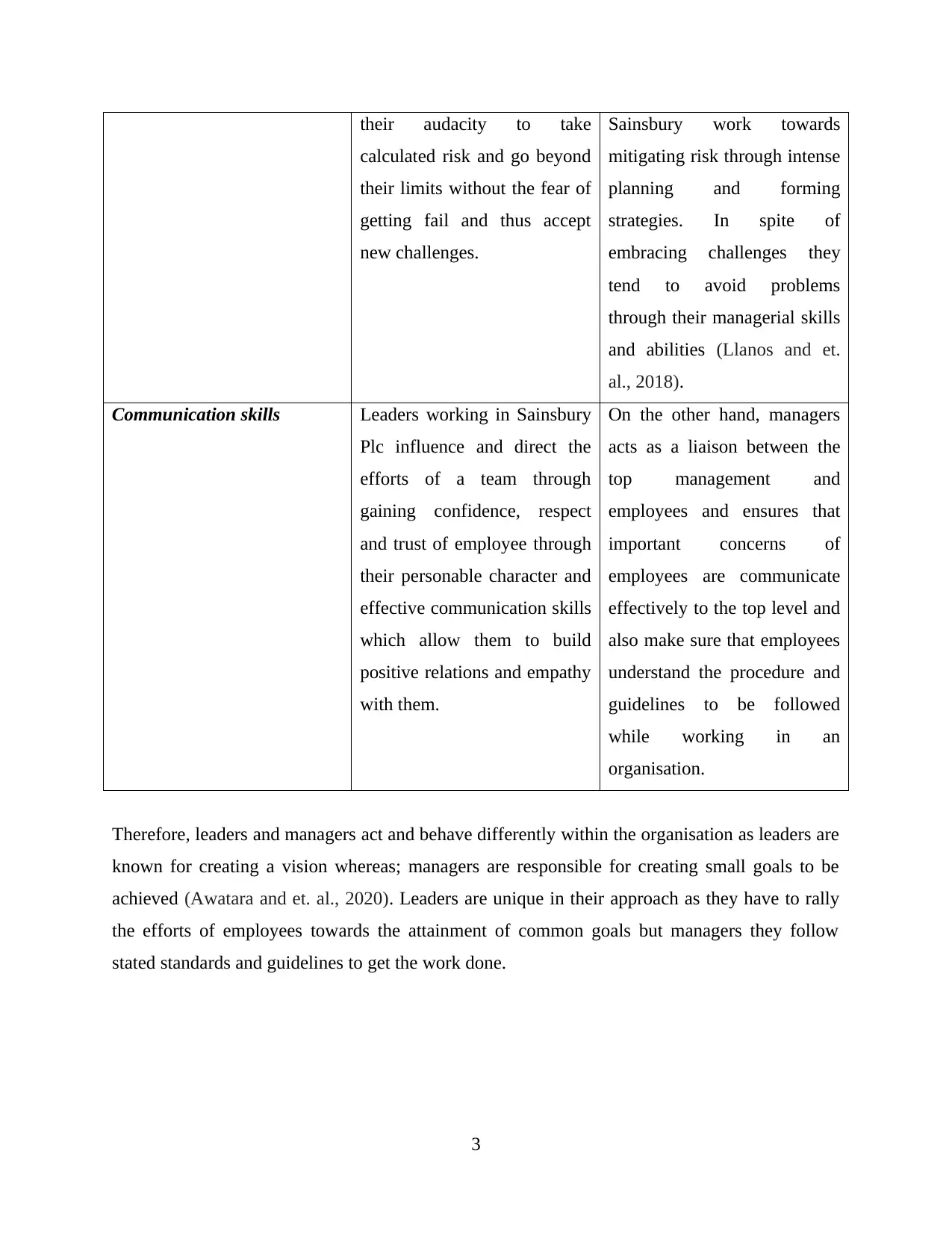
their audacity to take
calculated risk and go beyond
their limits without the fear of
getting fail and thus accept
new challenges.
Sainsbury work towards
mitigating risk through intense
planning and forming
strategies. In spite of
embracing challenges they
tend to avoid problems
through their managerial skills
and abilities (Llanos and et.
al., 2018).
Communication skills Leaders working in Sainsbury
Plc influence and direct the
efforts of a team through
gaining confidence, respect
and trust of employee through
their personable character and
effective communication skills
which allow them to build
positive relations and empathy
with them.
On the other hand, managers
acts as a liaison between the
top management and
employees and ensures that
important concerns of
employees are communicate
effectively to the top level and
also make sure that employees
understand the procedure and
guidelines to be followed
while working in an
organisation.
Therefore, leaders and managers act and behave differently within the organisation as leaders are
known for creating a vision whereas; managers are responsible for creating small goals to be
achieved (Awatara and et. al., 2020). Leaders are unique in their approach as they have to rally
the efforts of employees towards the attainment of common goals but managers they follow
stated standards and guidelines to get the work done.
3
calculated risk and go beyond
their limits without the fear of
getting fail and thus accept
new challenges.
Sainsbury work towards
mitigating risk through intense
planning and forming
strategies. In spite of
embracing challenges they
tend to avoid problems
through their managerial skills
and abilities (Llanos and et.
al., 2018).
Communication skills Leaders working in Sainsbury
Plc influence and direct the
efforts of a team through
gaining confidence, respect
and trust of employee through
their personable character and
effective communication skills
which allow them to build
positive relations and empathy
with them.
On the other hand, managers
acts as a liaison between the
top management and
employees and ensures that
important concerns of
employees are communicate
effectively to the top level and
also make sure that employees
understand the procedure and
guidelines to be followed
while working in an
organisation.
Therefore, leaders and managers act and behave differently within the organisation as leaders are
known for creating a vision whereas; managers are responsible for creating small goals to be
achieved (Awatara and et. al., 2020). Leaders are unique in their approach as they have to rally
the efforts of employees towards the attainment of common goals but managers they follow
stated standards and guidelines to get the work done.
3
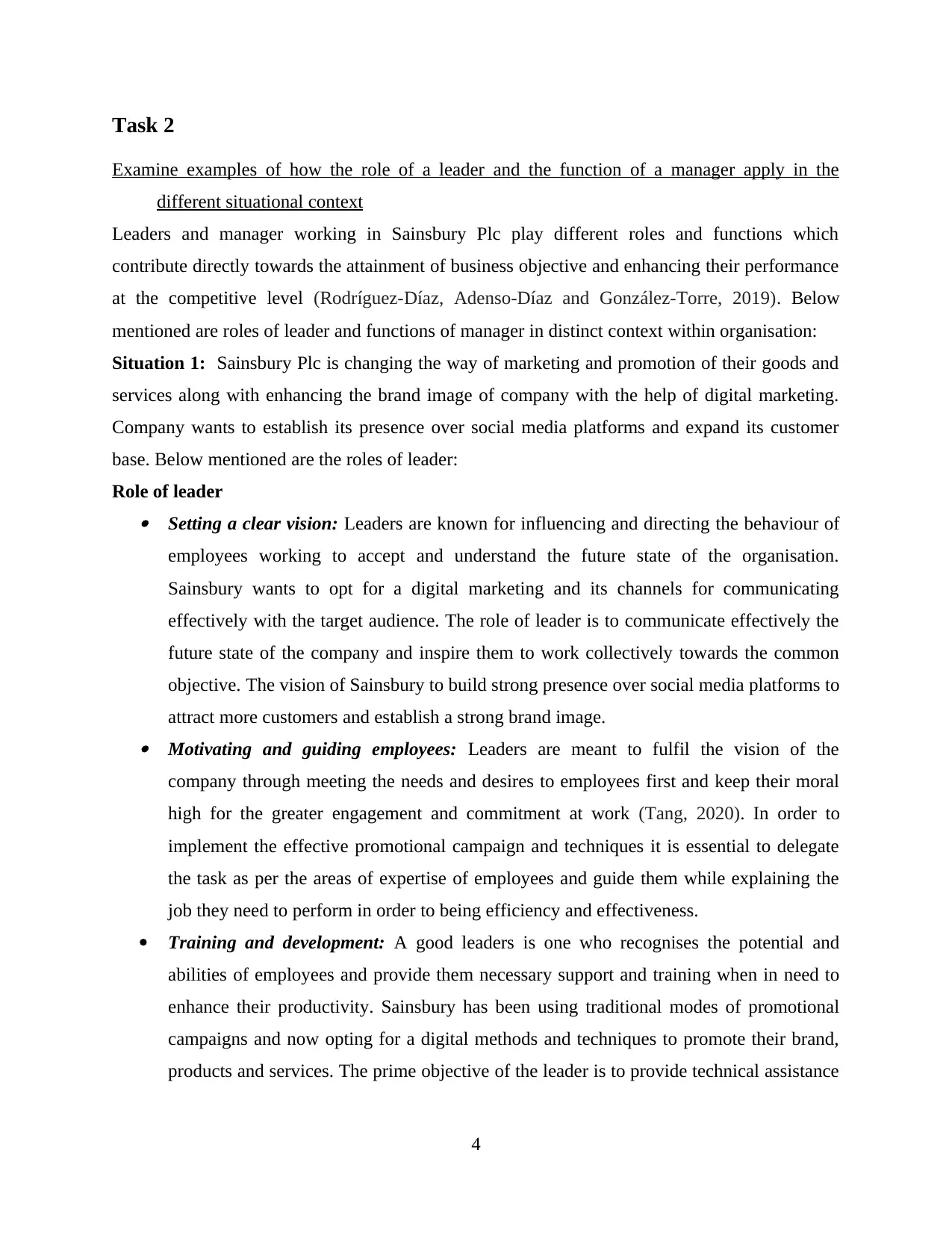
Task 2
Examine examples of how the role of a leader and the function of a manager apply in the
different situational context
Leaders and manager working in Sainsbury Plc play different roles and functions which
contribute directly towards the attainment of business objective and enhancing their performance
at the competitive level (Rodríguez-Díaz, Adenso-Díaz and González-Torre, 2019). Below
mentioned are roles of leader and functions of manager in distinct context within organisation:
Situation 1: Sainsbury Plc is changing the way of marketing and promotion of their goods and
services along with enhancing the brand image of company with the help of digital marketing.
Company wants to establish its presence over social media platforms and expand its customer
base. Below mentioned are the roles of leader:
Role of leader Setting a clear vision: Leaders are known for influencing and directing the behaviour of
employees working to accept and understand the future state of the organisation.
Sainsbury wants to opt for a digital marketing and its channels for communicating
effectively with the target audience. The role of leader is to communicate effectively the
future state of the company and inspire them to work collectively towards the common
objective. The vision of Sainsbury to build strong presence over social media platforms to
attract more customers and establish a strong brand image. Motivating and guiding employees: Leaders are meant to fulfil the vision of the
company through meeting the needs and desires to employees first and keep their moral
high for the greater engagement and commitment at work (Tang, 2020). In order to
implement the effective promotional campaign and techniques it is essential to delegate
the task as per the areas of expertise of employees and guide them while explaining the
job they need to perform in order to being efficiency and effectiveness.
Training and development: A good leaders is one who recognises the potential and
abilities of employees and provide them necessary support and training when in need to
enhance their productivity. Sainsbury has been using traditional modes of promotional
campaigns and now opting for a digital methods and techniques to promote their brand,
products and services. The prime objective of the leader is to provide technical assistance
4
Examine examples of how the role of a leader and the function of a manager apply in the
different situational context
Leaders and manager working in Sainsbury Plc play different roles and functions which
contribute directly towards the attainment of business objective and enhancing their performance
at the competitive level (Rodríguez-Díaz, Adenso-Díaz and González-Torre, 2019). Below
mentioned are roles of leader and functions of manager in distinct context within organisation:
Situation 1: Sainsbury Plc is changing the way of marketing and promotion of their goods and
services along with enhancing the brand image of company with the help of digital marketing.
Company wants to establish its presence over social media platforms and expand its customer
base. Below mentioned are the roles of leader:
Role of leader Setting a clear vision: Leaders are known for influencing and directing the behaviour of
employees working to accept and understand the future state of the organisation.
Sainsbury wants to opt for a digital marketing and its channels for communicating
effectively with the target audience. The role of leader is to communicate effectively the
future state of the company and inspire them to work collectively towards the common
objective. The vision of Sainsbury to build strong presence over social media platforms to
attract more customers and establish a strong brand image. Motivating and guiding employees: Leaders are meant to fulfil the vision of the
company through meeting the needs and desires to employees first and keep their moral
high for the greater engagement and commitment at work (Tang, 2020). In order to
implement the effective promotional campaign and techniques it is essential to delegate
the task as per the areas of expertise of employees and guide them while explaining the
job they need to perform in order to being efficiency and effectiveness.
Training and development: A good leaders is one who recognises the potential and
abilities of employees and provide them necessary support and training when in need to
enhance their productivity. Sainsbury has been using traditional modes of promotional
campaigns and now opting for a digital methods and techniques to promote their brand,
products and services. The prime objective of the leader is to provide technical assistance
4
⊘ This is a preview!⊘
Do you want full access?
Subscribe today to unlock all pages.

Trusted by 1+ million students worldwide
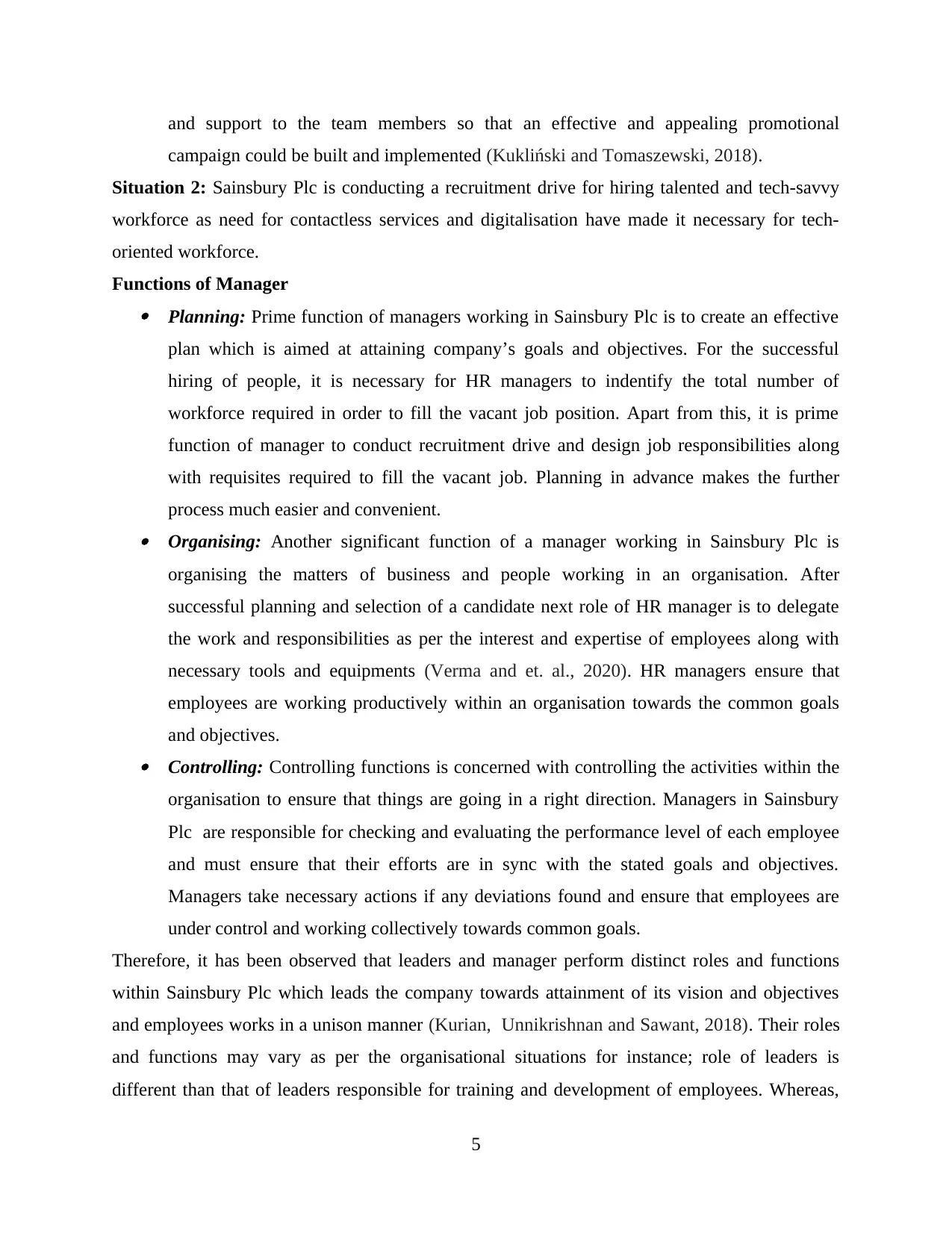
and support to the team members so that an effective and appealing promotional
campaign could be built and implemented (Kukliński and Tomaszewski, 2018).
Situation 2: Sainsbury Plc is conducting a recruitment drive for hiring talented and tech-savvy
workforce as need for contactless services and digitalisation have made it necessary for tech-
oriented workforce.
Functions of Manager Planning: Prime function of managers working in Sainsbury Plc is to create an effective
plan which is aimed at attaining company’s goals and objectives. For the successful
hiring of people, it is necessary for HR managers to indentify the total number of
workforce required in order to fill the vacant job position. Apart from this, it is prime
function of manager to conduct recruitment drive and design job responsibilities along
with requisites required to fill the vacant job. Planning in advance makes the further
process much easier and convenient. Organising: Another significant function of a manager working in Sainsbury Plc is
organising the matters of business and people working in an organisation. After
successful planning and selection of a candidate next role of HR manager is to delegate
the work and responsibilities as per the interest and expertise of employees along with
necessary tools and equipments (Verma and et. al., 2020). HR managers ensure that
employees are working productively within an organisation towards the common goals
and objectives. Controlling: Controlling functions is concerned with controlling the activities within the
organisation to ensure that things are going in a right direction. Managers in Sainsbury
Plc are responsible for checking and evaluating the performance level of each employee
and must ensure that their efforts are in sync with the stated goals and objectives.
Managers take necessary actions if any deviations found and ensure that employees are
under control and working collectively towards common goals.
Therefore, it has been observed that leaders and manager perform distinct roles and functions
within Sainsbury Plc which leads the company towards attainment of its vision and objectives
and employees works in a unison manner (Kurian, Unnikrishnan and Sawant, 2018). Their roles
and functions may vary as per the organisational situations for instance; role of leaders is
different than that of leaders responsible for training and development of employees. Whereas,
5
campaign could be built and implemented (Kukliński and Tomaszewski, 2018).
Situation 2: Sainsbury Plc is conducting a recruitment drive for hiring talented and tech-savvy
workforce as need for contactless services and digitalisation have made it necessary for tech-
oriented workforce.
Functions of Manager Planning: Prime function of managers working in Sainsbury Plc is to create an effective
plan which is aimed at attaining company’s goals and objectives. For the successful
hiring of people, it is necessary for HR managers to indentify the total number of
workforce required in order to fill the vacant job position. Apart from this, it is prime
function of manager to conduct recruitment drive and design job responsibilities along
with requisites required to fill the vacant job. Planning in advance makes the further
process much easier and convenient. Organising: Another significant function of a manager working in Sainsbury Plc is
organising the matters of business and people working in an organisation. After
successful planning and selection of a candidate next role of HR manager is to delegate
the work and responsibilities as per the interest and expertise of employees along with
necessary tools and equipments (Verma and et. al., 2020). HR managers ensure that
employees are working productively within an organisation towards the common goals
and objectives. Controlling: Controlling functions is concerned with controlling the activities within the
organisation to ensure that things are going in a right direction. Managers in Sainsbury
Plc are responsible for checking and evaluating the performance level of each employee
and must ensure that their efforts are in sync with the stated goals and objectives.
Managers take necessary actions if any deviations found and ensure that employees are
under control and working collectively towards common goals.
Therefore, it has been observed that leaders and manager perform distinct roles and functions
within Sainsbury Plc which leads the company towards attainment of its vision and objectives
and employees works in a unison manner (Kurian, Unnikrishnan and Sawant, 2018). Their roles
and functions may vary as per the organisational situations for instance; role of leaders is
different than that of leaders responsible for training and development of employees. Whereas,
5
Paraphrase This Document
Need a fresh take? Get an instant paraphrase of this document with our AI Paraphraser
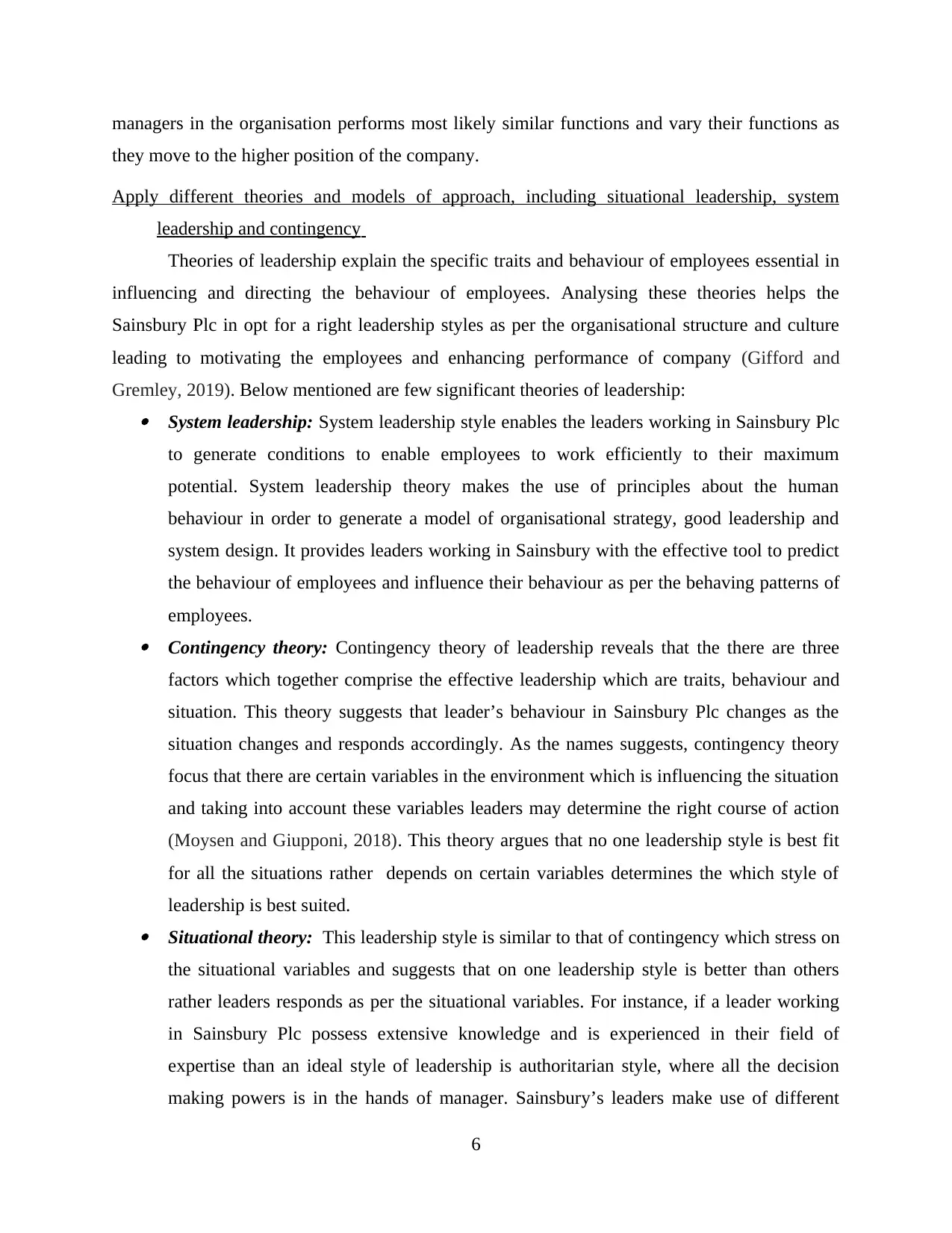
managers in the organisation performs most likely similar functions and vary their functions as
they move to the higher position of the company.
Apply different theories and models of approach, including situational leadership, system
leadership and contingency
Theories of leadership explain the specific traits and behaviour of employees essential in
influencing and directing the behaviour of employees. Analysing these theories helps the
Sainsbury Plc in opt for a right leadership styles as per the organisational structure and culture
leading to motivating the employees and enhancing performance of company (Gifford and
Gremley, 2019). Below mentioned are few significant theories of leadership: System leadership: System leadership style enables the leaders working in Sainsbury Plc
to generate conditions to enable employees to work efficiently to their maximum
potential. System leadership theory makes the use of principles about the human
behaviour in order to generate a model of organisational strategy, good leadership and
system design. It provides leaders working in Sainsbury with the effective tool to predict
the behaviour of employees and influence their behaviour as per the behaving patterns of
employees. Contingency theory: Contingency theory of leadership reveals that the there are three
factors which together comprise the effective leadership which are traits, behaviour and
situation. This theory suggests that leader’s behaviour in Sainsbury Plc changes as the
situation changes and responds accordingly. As the names suggests, contingency theory
focus that there are certain variables in the environment which is influencing the situation
and taking into account these variables leaders may determine the right course of action
(Moysen and Giupponi, 2018). This theory argues that no one leadership style is best fit
for all the situations rather depends on certain variables determines the which style of
leadership is best suited. Situational theory: This leadership style is similar to that of contingency which stress on
the situational variables and suggests that on one leadership style is better than others
rather leaders responds as per the situational variables. For instance, if a leader working
in Sainsbury Plc possess extensive knowledge and is experienced in their field of
expertise than an ideal style of leadership is authoritarian style, where all the decision
making powers is in the hands of manager. Sainsbury’s leaders make use of different
6
they move to the higher position of the company.
Apply different theories and models of approach, including situational leadership, system
leadership and contingency
Theories of leadership explain the specific traits and behaviour of employees essential in
influencing and directing the behaviour of employees. Analysing these theories helps the
Sainsbury Plc in opt for a right leadership styles as per the organisational structure and culture
leading to motivating the employees and enhancing performance of company (Gifford and
Gremley, 2019). Below mentioned are few significant theories of leadership: System leadership: System leadership style enables the leaders working in Sainsbury Plc
to generate conditions to enable employees to work efficiently to their maximum
potential. System leadership theory makes the use of principles about the human
behaviour in order to generate a model of organisational strategy, good leadership and
system design. It provides leaders working in Sainsbury with the effective tool to predict
the behaviour of employees and influence their behaviour as per the behaving patterns of
employees. Contingency theory: Contingency theory of leadership reveals that the there are three
factors which together comprise the effective leadership which are traits, behaviour and
situation. This theory suggests that leader’s behaviour in Sainsbury Plc changes as the
situation changes and responds accordingly. As the names suggests, contingency theory
focus that there are certain variables in the environment which is influencing the situation
and taking into account these variables leaders may determine the right course of action
(Moysen and Giupponi, 2018). This theory argues that no one leadership style is best fit
for all the situations rather depends on certain variables determines the which style of
leadership is best suited. Situational theory: This leadership style is similar to that of contingency which stress on
the situational variables and suggests that on one leadership style is better than others
rather leaders responds as per the situational variables. For instance, if a leader working
in Sainsbury Plc possess extensive knowledge and is experienced in their field of
expertise than an ideal style of leadership is authoritarian style, where all the decision
making powers is in the hands of manager. Sainsbury’s leaders make use of different
6
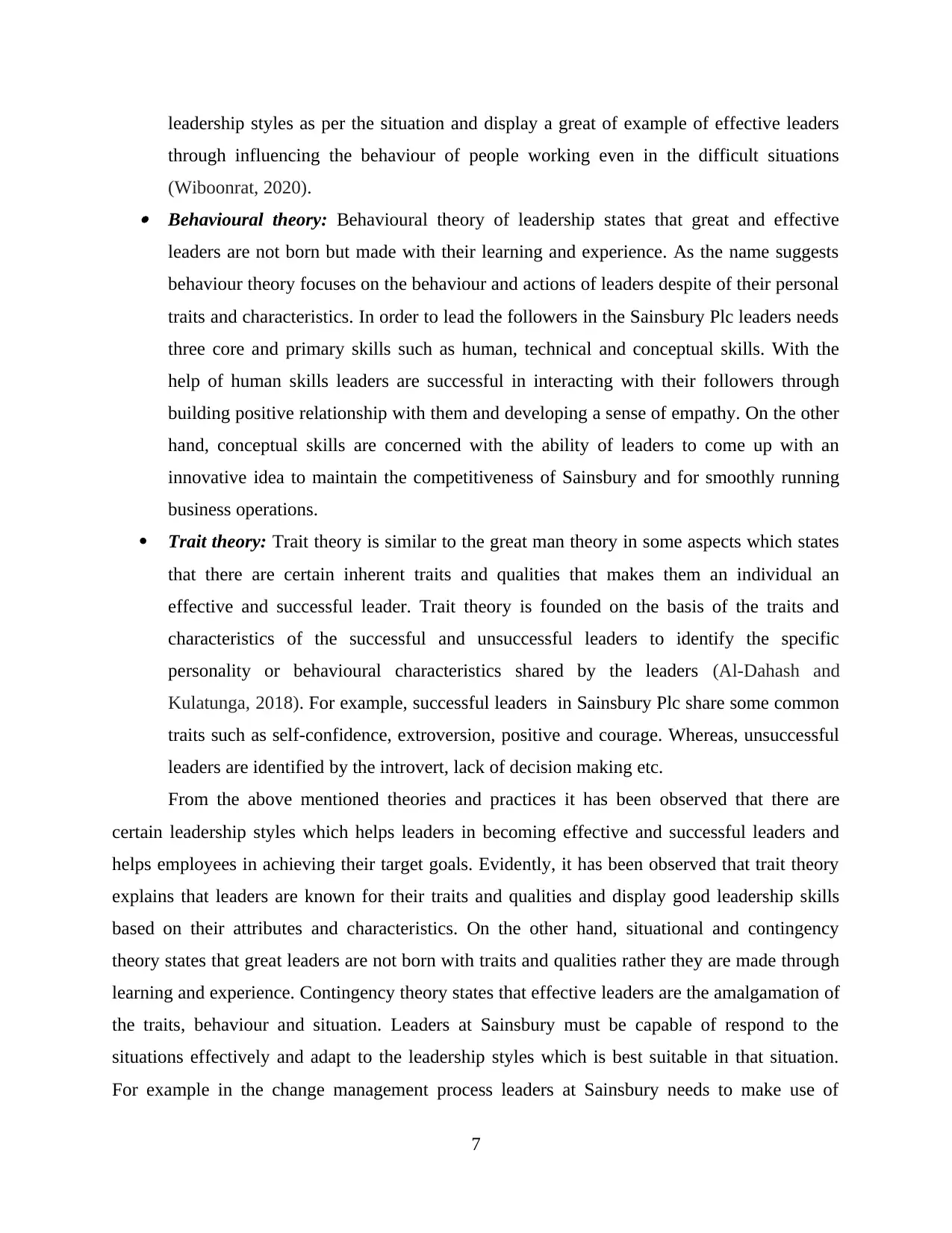
leadership styles as per the situation and display a great of example of effective leaders
through influencing the behaviour of people working even in the difficult situations
(Wiboonrat, 2020). Behavioural theory: Behavioural theory of leadership states that great and effective
leaders are not born but made with their learning and experience. As the name suggests
behaviour theory focuses on the behaviour and actions of leaders despite of their personal
traits and characteristics. In order to lead the followers in the Sainsbury Plc leaders needs
three core and primary skills such as human, technical and conceptual skills. With the
help of human skills leaders are successful in interacting with their followers through
building positive relationship with them and developing a sense of empathy. On the other
hand, conceptual skills are concerned with the ability of leaders to come up with an
innovative idea to maintain the competitiveness of Sainsbury and for smoothly running
business operations.
Trait theory: Trait theory is similar to the great man theory in some aspects which states
that there are certain inherent traits and qualities that makes them an individual an
effective and successful leader. Trait theory is founded on the basis of the traits and
characteristics of the successful and unsuccessful leaders to identify the specific
personality or behavioural characteristics shared by the leaders (Al-Dahash and
Kulatunga, 2018). For example, successful leaders in Sainsbury Plc share some common
traits such as self-confidence, extroversion, positive and courage. Whereas, unsuccessful
leaders are identified by the introvert, lack of decision making etc.
From the above mentioned theories and practices it has been observed that there are
certain leadership styles which helps leaders in becoming effective and successful leaders and
helps employees in achieving their target goals. Evidently, it has been observed that trait theory
explains that leaders are known for their traits and qualities and display good leadership skills
based on their attributes and characteristics. On the other hand, situational and contingency
theory states that great leaders are not born with traits and qualities rather they are made through
learning and experience. Contingency theory states that effective leaders are the amalgamation of
the traits, behaviour and situation. Leaders at Sainsbury must be capable of respond to the
situations effectively and adapt to the leadership styles which is best suitable in that situation.
For example in the change management process leaders at Sainsbury needs to make use of
7
through influencing the behaviour of people working even in the difficult situations
(Wiboonrat, 2020). Behavioural theory: Behavioural theory of leadership states that great and effective
leaders are not born but made with their learning and experience. As the name suggests
behaviour theory focuses on the behaviour and actions of leaders despite of their personal
traits and characteristics. In order to lead the followers in the Sainsbury Plc leaders needs
three core and primary skills such as human, technical and conceptual skills. With the
help of human skills leaders are successful in interacting with their followers through
building positive relationship with them and developing a sense of empathy. On the other
hand, conceptual skills are concerned with the ability of leaders to come up with an
innovative idea to maintain the competitiveness of Sainsbury and for smoothly running
business operations.
Trait theory: Trait theory is similar to the great man theory in some aspects which states
that there are certain inherent traits and qualities that makes them an individual an
effective and successful leader. Trait theory is founded on the basis of the traits and
characteristics of the successful and unsuccessful leaders to identify the specific
personality or behavioural characteristics shared by the leaders (Al-Dahash and
Kulatunga, 2018). For example, successful leaders in Sainsbury Plc share some common
traits such as self-confidence, extroversion, positive and courage. Whereas, unsuccessful
leaders are identified by the introvert, lack of decision making etc.
From the above mentioned theories and practices it has been observed that there are
certain leadership styles which helps leaders in becoming effective and successful leaders and
helps employees in achieving their target goals. Evidently, it has been observed that trait theory
explains that leaders are known for their traits and qualities and display good leadership skills
based on their attributes and characteristics. On the other hand, situational and contingency
theory states that great leaders are not born with traits and qualities rather they are made through
learning and experience. Contingency theory states that effective leaders are the amalgamation of
the traits, behaviour and situation. Leaders at Sainsbury must be capable of respond to the
situations effectively and adapt to the leadership styles which is best suitable in that situation.
For example in the change management process leaders at Sainsbury needs to make use of
7
⊘ This is a preview!⊘
Do you want full access?
Subscribe today to unlock all pages.

Trusted by 1+ million students worldwide

affiliative style which provides emotional support to the employees in bringing necessary
changes into the organisation (Mishra, Kumar and Hassini, 2019).
Part 2
Task 3
Explain the key approaches to operation management and role of leaders and managers play.
Below mentioned are the key approaches to the operation management in Sainsbury along
with the roles that leaders and managers play: Six sigma: One of the significant key approaches to the operations management used by
Sainsbury Plc is six sigma, which is concerned with focus on the manufacturing process.
Six sigma is a significant tool which is used by the many companies including Sainsbury
Plc which focused on improving the quality of a production process and cost reduction
method which in turn leads to the maximising the profitability of Sainsbury Plc and
increasing customer satisfaction. Main idea behind six sigma measure is to minimise the
defect rates in the production process of Sainsbury Plc which states that for every one
million produced goods, there should not be more the 3.4 deficiencies. One of the most
popular tool that Sainsbury use in their production process is DMAIC which is based on
five steps such as:
Define: At this stage, leaders and managers of operation management in Sainsbury Plc
determines the issue related with manufacturing process followed by improvement goals and
make use of appropriate tools and resources to deal with the problem (Fan and Stevenson, 2018).
Measure: Managers at this stage measures the performance of a process based on identified
matrices which is essential in getting an idea on how to improve the performance of a process.
Analysis: This stage is crucial as at this stage managers finds out the reasons for the
underperforming of a production process.
Improvement: After identifying the root cause of a issue why manufacturing process is
underperforming, manager makes an effort to find out the potential problems related with the
problem or cause.
Control: Managers of Sainsbury Plc at this stage implements the new developed process and
evaluate the performance of the production process by setting benchmarks the new result with
old one.
8
changes into the organisation (Mishra, Kumar and Hassini, 2019).
Part 2
Task 3
Explain the key approaches to operation management and role of leaders and managers play.
Below mentioned are the key approaches to the operation management in Sainsbury along
with the roles that leaders and managers play: Six sigma: One of the significant key approaches to the operations management used by
Sainsbury Plc is six sigma, which is concerned with focus on the manufacturing process.
Six sigma is a significant tool which is used by the many companies including Sainsbury
Plc which focused on improving the quality of a production process and cost reduction
method which in turn leads to the maximising the profitability of Sainsbury Plc and
increasing customer satisfaction. Main idea behind six sigma measure is to minimise the
defect rates in the production process of Sainsbury Plc which states that for every one
million produced goods, there should not be more the 3.4 deficiencies. One of the most
popular tool that Sainsbury use in their production process is DMAIC which is based on
five steps such as:
Define: At this stage, leaders and managers of operation management in Sainsbury Plc
determines the issue related with manufacturing process followed by improvement goals and
make use of appropriate tools and resources to deal with the problem (Fan and Stevenson, 2018).
Measure: Managers at this stage measures the performance of a process based on identified
matrices which is essential in getting an idea on how to improve the performance of a process.
Analysis: This stage is crucial as at this stage managers finds out the reasons for the
underperforming of a production process.
Improvement: After identifying the root cause of a issue why manufacturing process is
underperforming, manager makes an effort to find out the potential problems related with the
problem or cause.
Control: Managers of Sainsbury Plc at this stage implements the new developed process and
evaluate the performance of the production process by setting benchmarks the new result with
old one.
8
Paraphrase This Document
Need a fresh take? Get an instant paraphrase of this document with our AI Paraphraser

Total quality management: Total quality management is the term which was coined in the year
1950 and is equivalent to the company wide quality management system or integrated quality
management system. Sainsbury Plc with the TQM techniques is primarily concerned with use of
managerial and technical methods to achieve quality standards and business objectives
throughout the entire organisation (Choi and Sethi, 2021). It is a holistic approach in maintaining
quality where each department and functions of Sainsbury are involved in quality management.
Managers at Sainsbury Plc ensure that each department and employees make collective efforts
towards enhancing and maintaining desired quality in an organisation. Lean and Agile manufacturing: The term lean manufacturing was established by Toyota
and is widely used by many industries and business firms which is concerned with the
improvement of production process with the aim of reducing wastage and inventory,
maximise the output of high quality products and reducing the cost of goods and services.
Whereas, agile manufacturing is a new concept which traces its origin from software
development but now used by many firms including Sainsbury Plc. It came into existence
due to the growing complexity of production process with the aim to keep manufacturing
firms update with the current functioning so that different departments such as marketing,
sales and production can have access to the same data system and can work efficiently
and effectively (Dachkovskyi, 2021).
Reconfiguration manufacturing system: Changes are inherent into the nature and in the
business environment which affects the profitability and performance level of a
Sainsbury Plc in a long run and cause disruptions into the operations of a business.
Sainsbury Plc makes use of reconfiguration manufacturing system into their business
operations which allow company to quickly and easily adapting to the changes in the
market in relation to the demand and supply. It is a production system which comes with
a different functionalities an can be used in a product family to make necessary changes
into production cost effectively. Managers at Sainsbury ensure that both hardware and
software are implemented in the initial design to handle swift adjustments when
necessary.
Explain the importance and value of operations management in achieving business objectives.
Operation management is the significant branch of an overall business of Sainsbury Plc
which is a process that takes into account planning, organising, controlling and supervising
9
1950 and is equivalent to the company wide quality management system or integrated quality
management system. Sainsbury Plc with the TQM techniques is primarily concerned with use of
managerial and technical methods to achieve quality standards and business objectives
throughout the entire organisation (Choi and Sethi, 2021). It is a holistic approach in maintaining
quality where each department and functions of Sainsbury are involved in quality management.
Managers at Sainsbury Plc ensure that each department and employees make collective efforts
towards enhancing and maintaining desired quality in an organisation. Lean and Agile manufacturing: The term lean manufacturing was established by Toyota
and is widely used by many industries and business firms which is concerned with the
improvement of production process with the aim of reducing wastage and inventory,
maximise the output of high quality products and reducing the cost of goods and services.
Whereas, agile manufacturing is a new concept which traces its origin from software
development but now used by many firms including Sainsbury Plc. It came into existence
due to the growing complexity of production process with the aim to keep manufacturing
firms update with the current functioning so that different departments such as marketing,
sales and production can have access to the same data system and can work efficiently
and effectively (Dachkovskyi, 2021).
Reconfiguration manufacturing system: Changes are inherent into the nature and in the
business environment which affects the profitability and performance level of a
Sainsbury Plc in a long run and cause disruptions into the operations of a business.
Sainsbury Plc makes use of reconfiguration manufacturing system into their business
operations which allow company to quickly and easily adapting to the changes in the
market in relation to the demand and supply. It is a production system which comes with
a different functionalities an can be used in a product family to make necessary changes
into production cost effectively. Managers at Sainsbury ensure that both hardware and
software are implemented in the initial design to handle swift adjustments when
necessary.
Explain the importance and value of operations management in achieving business objectives.
Operation management is the significant branch of an overall business of Sainsbury Plc
which is a process that takes into account planning, organising, controlling and supervising
9
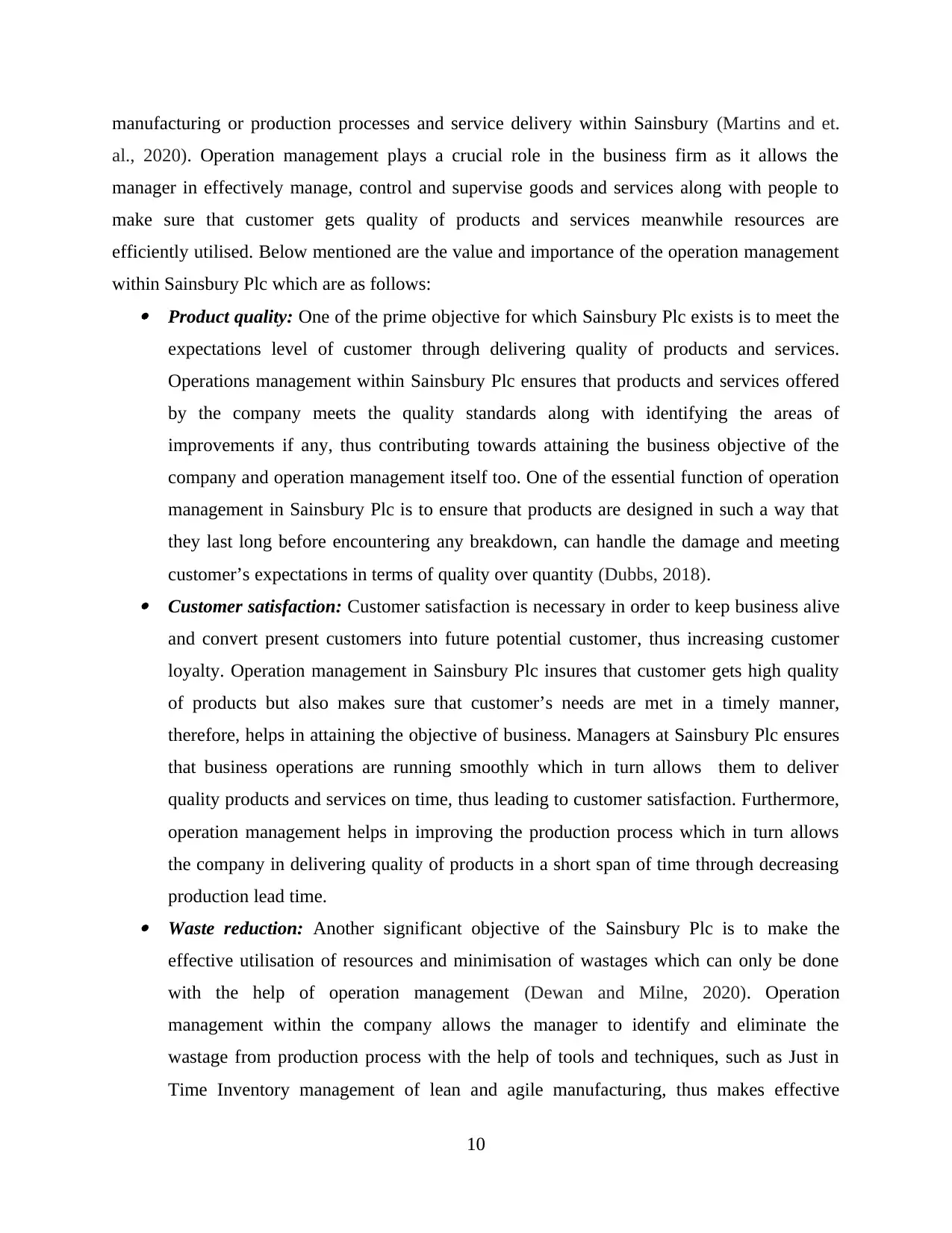
manufacturing or production processes and service delivery within Sainsbury (Martins and et.
al., 2020). Operation management plays a crucial role in the business firm as it allows the
manager in effectively manage, control and supervise goods and services along with people to
make sure that customer gets quality of products and services meanwhile resources are
efficiently utilised. Below mentioned are the value and importance of the operation management
within Sainsbury Plc which are as follows: Product quality: One of the prime objective for which Sainsbury Plc exists is to meet the
expectations level of customer through delivering quality of products and services.
Operations management within Sainsbury Plc ensures that products and services offered
by the company meets the quality standards along with identifying the areas of
improvements if any, thus contributing towards attaining the business objective of the
company and operation management itself too. One of the essential function of operation
management in Sainsbury Plc is to ensure that products are designed in such a way that
they last long before encountering any breakdown, can handle the damage and meeting
customer’s expectations in terms of quality over quantity (Dubbs, 2018). Customer satisfaction: Customer satisfaction is necessary in order to keep business alive
and convert present customers into future potential customer, thus increasing customer
loyalty. Operation management in Sainsbury Plc insures that customer gets high quality
of products but also makes sure that customer’s needs are met in a timely manner,
therefore, helps in attaining the objective of business. Managers at Sainsbury Plc ensures
that business operations are running smoothly which in turn allows them to deliver
quality products and services on time, thus leading to customer satisfaction. Furthermore,
operation management helps in improving the production process which in turn allows
the company in delivering quality of products in a short span of time through decreasing
production lead time. Waste reduction: Another significant objective of the Sainsbury Plc is to make the
effective utilisation of resources and minimisation of wastages which can only be done
with the help of operation management (Dewan and Milne, 2020). Operation
management within the company allows the manager to identify and eliminate the
wastage from production process with the help of tools and techniques, such as Just in
Time Inventory management of lean and agile manufacturing, thus makes effective
10
al., 2020). Operation management plays a crucial role in the business firm as it allows the
manager in effectively manage, control and supervise goods and services along with people to
make sure that customer gets quality of products and services meanwhile resources are
efficiently utilised. Below mentioned are the value and importance of the operation management
within Sainsbury Plc which are as follows: Product quality: One of the prime objective for which Sainsbury Plc exists is to meet the
expectations level of customer through delivering quality of products and services.
Operations management within Sainsbury Plc ensures that products and services offered
by the company meets the quality standards along with identifying the areas of
improvements if any, thus contributing towards attaining the business objective of the
company and operation management itself too. One of the essential function of operation
management in Sainsbury Plc is to ensure that products are designed in such a way that
they last long before encountering any breakdown, can handle the damage and meeting
customer’s expectations in terms of quality over quantity (Dubbs, 2018). Customer satisfaction: Customer satisfaction is necessary in order to keep business alive
and convert present customers into future potential customer, thus increasing customer
loyalty. Operation management in Sainsbury Plc insures that customer gets high quality
of products but also makes sure that customer’s needs are met in a timely manner,
therefore, helps in attaining the objective of business. Managers at Sainsbury Plc ensures
that business operations are running smoothly which in turn allows them to deliver
quality products and services on time, thus leading to customer satisfaction. Furthermore,
operation management helps in improving the production process which in turn allows
the company in delivering quality of products in a short span of time through decreasing
production lead time. Waste reduction: Another significant objective of the Sainsbury Plc is to make the
effective utilisation of resources and minimisation of wastages which can only be done
with the help of operation management (Dewan and Milne, 2020). Operation
management within the company allows the manager to identify and eliminate the
wastage from production process with the help of tools and techniques, such as Just in
Time Inventory management of lean and agile manufacturing, thus makes effective
10
⊘ This is a preview!⊘
Do you want full access?
Subscribe today to unlock all pages.

Trusted by 1+ million students worldwide
1 out of 17
Related Documents
Your All-in-One AI-Powered Toolkit for Academic Success.
+13062052269
info@desklib.com
Available 24*7 on WhatsApp / Email
![[object Object]](/_next/static/media/star-bottom.7253800d.svg)
Unlock your academic potential
Copyright © 2020–2025 A2Z Services. All Rights Reserved. Developed and managed by ZUCOL.





